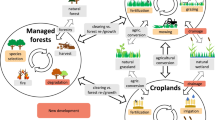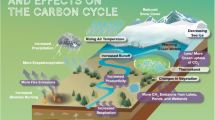Abstract
Context
Accurately predicting microclimate is considered a high priority for understanding organismal responses to climate change at biologically relevant scales. However, approaches to developing robust microclimate datasets and understanding of the biophysical processes altering microclimatic regimes are limited.
Objectives
We developed and evaluated an approach for predicting microclimatic temperatures in montane forests that incorporates the influence of complex vegetation structure and landscape physiography. Additionally, we determined spatiotemporal mismatches between free-air and microclimatic temperatures to highlight the location, phenology, and magnitude of differences in predicted temperature.
Methods
We combined temperature datalogger measurements with LiDAR-derived vegetation and GIS-derived landscape physiographic characteristics to downscale free-air temperatures to microclimatic (3 m2 spatial resolution) temperatures in the Great Smoky Mountains. We assessed the contribution of forest vegetation layers in altering microclimatic temperatures and model accuracy, and compared coarse-grain temperature maps with microclimatic temperature maps.
Results
Understory vegetation structure contributes to microclimatic buffering of near-surface, forest temperatures and enhances the accuracy of maximum temperature predictions during the growing season by altering the effects of solar insolation and topographic convergence index on microclimatic temperatures. Elevation and solar insolation covaried with spatiotemporal mismatches between free-air and microclimatic temperatures, suggesting that these landscape physiographic characteristics may contribute to deviations between macro- and micro-scale temperature.
Conclusions
Our findings demonstrate the importance of including complex vegetation characteristics and biophysical interactions as climate forcing factors in microclimate modeling. We also demonstrate the plausibility of accurately predicting microclimatic temperatures over broad extents, an important step in predicting potential organismal responses to climate change.







Similar content being viewed by others
References
Ashcroft MB (2010) Identifying refugia from climate change. J Biogeogr 37:1407–1413
Ashcroft MB, Gollan JR (2012) Fine-resolution (25 m) topoclimatic grids of near-surface (5 cm) extreme temperatures and humidities across various habitats in a large (200-300 km) and diverse region. - Int. J Climatol 32:2134–2148
Ashcroft MB, Chisholm LA, French KO (2008) The effect of exposure on landscape scale soil surface temperatures and species distribution models. Landsc Ecol 23:211–225
Beven KJ, Kirkby MJ (1979) A physically based, variable contributing area model of basin hydrology. Hydrol Sci Bull 24:43–69
Bolstad PV, Swift L, Collins F, Régnière J (1998) Measured and predicted air temperatures at basin to regional scales in the southern Appalachian mountains. Agric For Meteorol 91:161–176
Bramer I, Anderson BJ, Bennie J, Bladon AJ, De Frenne P, Hemming D, Hill RA, Kearney MR, Körner C, Korstjens AH, Lenoir J, Maclean IMD, Marsh CD, Morecroft MD, Ohlemüller R, Slater HD, Suggitt AJ, Zellweger F, Gillingham PK (2018) Advances in monitoring and modelling climate at ecologically relevant scales. Adv Ecol Res 58:101–161
Burnham KP, Anderson DR (2002) Model selection and multimodel inference: a practical information-theoretic approach (2nd ed). Library of Congress Cataloging-in- Publication Data
Chazdon RL (1988) Sunflecks and their importance to forest understorey plants. Adv Ecol 18:1–63
Chen J, Franklin JF (1997) Growing-season microclimate variability within an old-growth Douglas-fir forest. Clim Res 8:21–34
Chen J, Saunders SC, Crow TR, Naiman RJ, Brosofske KD, Mroz GD, Brookshire BL, Franklin JF (1999) Microclimate in forest ecosystem and landscape ecology—variations in local climate can be used to monitor and compare the effects of different management regimes. Bioscience 49:288–297
Clinton BD (2003) Light, temperature, and soil moisture responses to elevation, evergreen understory, and small canopy gaps in the southern Appalachians. For Ecol Manag 186:243–255
Dai A, Trenberth K (1999) Effects of clouds, soil moisture, precipitation, and water vapor on diurnal temperature range. J Clim 12:2451–2474
Daly C, Neilson RP, Phillips DL (1994) A statistical-topographic model for mapping climatological precipitation over mountainous Terrain. J Appl Meteorol 33(2):140–158
Davis KT, Dobrowski SC, Holden ZA, Higuera PE, Abatzoglou JT (2018) Microclimatic buffering in forests of the future: the role of local water balance. Ecography 42(1):1–11
Day FP, Monk CD (1974) Vegetation patterns on a southern Appalachian watershed. Ecology 55:1064–1074
De Frenne P, Verheyen K (2016) Weather stations lack forest data. Science 351(6270):234
De Frenne P, Zellweger F, Rodríguez-Sánchez F, Scheffers BR, Hylander K, Luoto M, Vellend M, Verheyen K, Lenoir J (2019) Global buffering of temperatures under forest canopies. Nat Ecol Evol 3:744–749
Detlef H (1977) The distribution of solar radiation within a deciduous forest. Ecol Monogr 47:185–207
Elsen PR, Tingley MW (2015) Global mountain topography and the fate of montane species under climate change. Nat Clim Chang 5:772–776
Esri Inc (2020) ArcGIS Desktop (version 10.4.1-10.6.1). Software. Redlands, CA
Franklin J, Davis FW, Ikegami M, Syphard AD, Flint LE, Flint AL, Hannah L (2013) Modeling plant species distributions under future climates: how fine scale do climate projections need to be? Glob Chang Biol 19:473–483
Frey SJK, Hadley AS, Johnson SL, Schulze M, Jones JA, Betts MG (2016) Spatial models reveal the microclimatic buffering capacity of old-growth forests. Sci Adv 2(4):e1501392
Fridley JD (2009) Downscaling climate over complex terrain: high finescale (< 1000 m) spatial variation of near-ground temperatures in a montane forested landscape (Great Smoky Mountains). J Appl Meteorol Climatol 48:1033–1049
Geiger R, Aron RH, Todhunter P (2009) The climate near the ground, 7th edn. Rowman and Littlefield, Lanham
Gillingham PK, Palmer SCF, Huntley B, Kunin WE, Chipperfield JD, Thomas CD (2012a) The relative importance of climate and habitat in determining the distributions of species at different spatial scales: a case study with ground beetles in Great Britain. Ecography 35:831–838
Gillingham PK, Huntley B, Kunin WE, Thomas CD (2012b) The effect of spatial resolution on projected responses to climate warming. Divers Distrib 18:990–1000
GRASS Development Team (2017) Geographic Resources Analysis Support System (GRASS) Software, Version 7.2. Open Source Geospatial Foundation. Electronic document: http://grass.osgeo.org. LiDAR Analysis of Vegetation Structure: https://grasswiki.osgeo.org/wiki/Lidar_Analysis_of_Vegetation_Structure
Hannah L, Flint L, Syphard AD, Moritz MA, Buckley LB, McCullough IM (2014) Fine-grain modeling of species’ response to climate change: holdouts, stepping-stones, and microrefugia. Trends Ecol Evol 29:390–397
Helmuth B, Broitman BR, Yamane L, Gilman SE, Mach K, Mislan KAS, Denny MW (2010) Organismal climatology: analyzing environmental variability at scales relevant to physiological stress. J Exp Biol 213:995–1003
Hicks DJ, Chabot BF (1985) Deciduous forest. In: Chabot BF, Mooney HA (eds) Physiological ecology of North American plant communities. Chapman and Hall, New York, pp 257–277
Jennings SB, Brown ND, Sheil D (1999) Assessing forest canopies and understorey illumination: canopy closure, canopy cover and other measures. Forestry 72:59–74
Jones HG (2014) Plants and microclimate. A quantitative approach to environmental plant physiology, vol 7, 3rd edn. Cambridge University Press, Cambridge
Jordan T, Madden M, Yang B, Sharma JB, Panda S (2011) Acquisition of LiDAR for the Tennessee portion of Great Smoky Mountains National Park and the Foothills Parkway. Center for Remote Sensing and Mapping Science (CRMS), Department of Geography, The University of Georgia, Athens, Georgia, USA, Tech. Rep. USGS Contract # G10AC0015
Jucker T, Hardwick SR, Both S, Elias DMO, Ewers RM, Milodowski DT, Swinfield T, Coomes DA (2018) Canopy structure and topography jointly constrain the microclimate of human-modified tropical landscapes. Glob Chang Biol 24:5243–5258
Kearney M, Porter W (2009) Mechanistic niche modelling: combining physiological and spatial data to predict species’ ranges. Ecol Lett 12:334–350
Kiefer MT, Zhong S (2013) The effect of sidewall forest canopies on the formation of cold- air pools: a numerical study. J Geophys Res D: Atmos 118:5965–5978
Koizumi H, Oshima Y (1993) Light environment and carbon gain of understory herbs associated with sunflecks in a warm temperate deciduous forest in Japan. Ecol Res 8:135–142
Lefsky MA, Cohen WB, Parker GG, Harding DJ (2002) Lidar remote sensing for ecosystem studies. Bioscience 52:19
Lembrechts JJ, Nijs I, Lenoir J (2018) Incorporating microclimate into species distribution models. Ecography 42:1267–1279
Lenoir J, Hattab T, Pierre G (2017) Climatic microrefugia under anthropogenic climate change: implications for species redistribution. Ecography 40:253–266
Lookingbill T (2002) Spatial estimation of air temperature differences for landscape-scale studies in montane environments. Agric For Meteorol 114:141–151
Meineri E, Hylander K (2017) Fine-grain, large-domain climate models based on climate station and comprehensive topographic information improve microrefugia detection. Ecography 40:1003–1013
Norman SP, Hargrove WW, Christie WM (2017) Spring and autumn phenological variability across environmental gradients of Great Smoky Mountains National Park, USA. Remote Sens 9(5):407
Novick K, Ficklin DL, Stoy PC, Williams CA, Bohrer G, Oishi AC, Papuga SA, Blanken PD, Noormets A, Sulman BN, Scott RL, Wang L, Phillips RP (2016) The increasing importance of atmospheric demand for ecosystem water and carbon fluxes. Nat Clim Change 6:1023–1027
OCM Partners (2019) 2005 NCFMP Lidar: NC Statewide Phase 3 from 2010-06-15 to 2010-08- 15. NOAA National Centers for Environmental Information. https://inport.nmfs.noaa.gov/inport/item/49833
Pinheiro J, Bates D, DebRoy S, Sarkar, D, R Core Team (2020). nlme: linear and nonlinear mixed effects models. R package version 3.1-151. https://CRAN.R-project.org/package=nlme
Potter KA, Woods HA, Pincebourde S (2013) Microclimatic challenges in global change biology. Glob Change Biol 19:2932–2939
PRISM Climate Group (2020) Oregon State University, http://prism.oregonstate.edu. Accepted 4 Feb 2004
Randin CF, Engler R, Normand S, Zappa M, Zimmermann NE, Pearman PB, Vittoz P, Thuiller W, Guisan A (2009) Climate change and plant distribution: local models predict high-elevation persistence. Glob Change Biol 15:1557–1569
Scherrer D, Körner C (2010) Infra-red thermometry of alpine landscapes challenges climatic warming projections. Glob Chang. Biol 16:2602–2613
Singer JD, Willett JB (2003) Applied longitudinal data analysis: modeling change and event occurrence. Oxford University Press, Oxford
Suggitt AJ, Gillingham PK, Hill JK, Huntley B, Kunin WE, Roy DB, Thomas CD (2011) Habitat microclimates drive fine-scale variation in extreme temperatures. Oikos 120(1):1–8
R Core Team (2020) R: a language and environment for statistical computing. R Foundation for Statistical Computing, Vienna, Austria. http://www.R-project.org/. Computing, Vienna, Austria. http://www.R-project.org/
Thornton MM, Thornton PE, Wei Y, Mayer BW, Cook RB, Vose RS (2018) Daymet: annual climate summaries on a 1-km grid for North America, Version 3. ORNL DAAC, Oak Ridge, Tennessee, USA. https://doi.org/10.3334/ORNLDAAC/1343
Trivedi MR, Berry PM, Morecroft MD, Dawson TP (2008) Spatial scale affects bioclimate model projections of climate change impacts on mountain plants. Glob Change Biol 14:1089–1103
Vanwalleghem T, Meentemeyer RK (2009) Predicting forest microclimate in heterogeneous landscapes. Ecosystems 12:1158–1172
Washitani I, Tang Y (1991) Microsite variation in light availability and seedling growth of Quercus serrata in a temperate pine forest. Ecol Res 6:305–316
Whittaker RH (1956) Vegetation of the Great Smoky Mountains. Ecol Monogr 26(1):1–80
Wilson JB (2011) Cover plus: ways of measuring plant canopies and the terms used for them. J Veg Sci 22:197–206
Zellweger F, De Frenne P, Lenoir J, Rocchini D, Coomes D (2019) Advances in microclimate ecology arising from remote sensing. Trends Ecol Evol 34:327–341
Zuur A, Leno EN, Walker NJ, Saveliev AA, Smith GM (2009) Mixed effects models and extensions in ecology with R. Springer, Berlin
Acknowledgements
S.F.S and J.M.F were funded by the National Science Foundation (award #1339944). We thank Jason Fridley for sharing the temperature logger data, Thomas Jordan for assisting with the TN LiDAR dataset, and Doug Newcomb for recommendations on calculating vegetation density characteristics.
Author information
Authors and Affiliations
Corresponding author
Ethics declarations
Conflict of interest
The authors declare that they have no known competing financial interests or personal relationships that could have appeared to influence the work reported in this paper.
Additional information
Publisher's Note
Springer Nature remains neutral with regard to jurisdictional claims in published maps and institutional affiliations.
Supplementary Information
Below is the link to the electronic supplementary material.
Rights and permissions
About this article
Cite this article
Stickley, S.F., Fraterrigo, J.M. Understory vegetation contributes to microclimatic buffering of near-surface temperatures in temperate deciduous forests. Landscape Ecol 36, 1197–1213 (2021). https://doi.org/10.1007/s10980-021-01195-w
Received:
Accepted:
Published:
Issue Date:
DOI: https://doi.org/10.1007/s10980-021-01195-w




